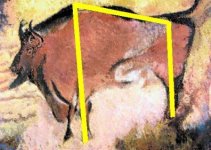Milfoil
Anglo Saxon rune poem:
The aurochs is proud and has great horns;
it is a very savage beast and fights with its horns;
a great ranger of the moors, it is a creature of
mettle.
Norwegian:
Dross comes from bad iron;
the reindeer often races over the frozen snow.
Icelandic:
Shower
lamentation of the clouds
and ruin of the hay-harvest
and abomination of the shepherd.
Looking at these three verses which we assume pertain to the rune Uruz (I say assume because we can never be perfectly sure) I see a slightly different way of perceiving this rune meaning.
A major part of most older societies was the rite of passage where young people, mostly boys, went out to face their fears and prove themselves. Many young boys would start out their adult lives doing menial jobs such as herding sheep or cattle, much as they still do today in Swizerland, Africa and the Middle East. The job of milking the sheep and cattle was for the younger women. When the time came for a young man to prove himself in Norse society, this may have been done by the hunting down and killing of the Auroch. The horns of the Auroch or any other horned animal were symbols of the connection to the sky and therefore to the three upper worlds of the Gods (Asgard, Vanaheimr and Álfheimr). There could be a connection between specific animals and specific upper worlds but that would be a matter for another discussion.
The Auroch horn was massive, the only horn large enough that when cleaned out would hold enough mead for a Sumbel in a large group (the whole community) or a Blot. Very basically, the Sumbel is a round of three toasts where the horn is passed around the group and each person toasts the Gods, a boast and an oath. A Blot is more sacred rite involving feasting which is dedicated to the Gods. (Very generalised, I know but for the sake of brevity here).
Looking at the three verses, each one talks about the challenge and about above and below. In the earliest of the poems, the Anglo-Saxon one (written around 1000 CE), the Auroch is the key, the challenge is to find, face and challenge this incredible master of the open moor. An act of skill and bravery which would give an incredible amount of meat, bone, sinew and hide to the community. The horns of the biggest Auroch bull would be highly prized as symbols of communal and important rituals - a true gift from the Gods, a great boast and a confirmation of the oath made between that young man and his community who he had now earned the right to sit amongst as a man. Some would not have survivied so this was a true test of hardship and valor.
In the second verse from the Norwegian poem it talks about dross from the bad iron. Dross is the scum that floats to the surface when smelting iron, not the slag that is left behind. In this verse, both lines talk about what is above the surface and about heat and cold. When put to the test in the heat of the furnace, ie when challenged to become pure and of use, the dross or 'bad iron' must be skimmed off and this cannot happen unless the iron is heated to crisis point. Likewise, when the earth freezes and all seems lost, no growth, no food, no warmth, no light in the deepest and harshest part of winter, we can use this to our advantage and move swiftly like the Reindeer over the frozen snow. Again, these two images talk about challenge and turning the harsh problem into a new answer. This idea of challenge and transformation only coming about through being tested links with the earlier Auroch verse. Though if you were to go out to challenge an Auroch, it would be more appropriate and sensible to do this in the coldest part of winter when the meat is needed and the Auroch is weaker. Trying to run and chase a BIG mammal over soft, wet ground up on the moors is very difficult, especially when this animal is in its element and could end up chasing you. When all is frozen - it is easier to track and move across such country which is where the ideas of moving across frozen snow may come from.
Then we come to the last, 13th C Icelandic poem verse which speaks of rain, loss of crops and herdsmen. The challenge here is to face what cannot be altered. Endure and survive. It is interesting that this verse comes at a time when between 600 and 1500 AD, the climate was warmer and wetter. http://www.ncdc.noaa.gov/paleo/globalwarming/images/last2000-large.jpg
As is the rainy summer of 1315, which was so wet that on July 15 that it is thought to be the origin of the St Swithin’s Day belief that if it rains on that day, it will continue for 40 more.
From: http://www.telegraph.co.uk/topics/weather/8968354/Worst-winters-of-last-2000-years.html
So the challenge and endurance has changed from the original idea of testing someone's mettel by typical rite of passage to a more general testing based on the changes all around them. Having gone from a crossover hunter-farmer society to full farming with fewer Aurochs to be found, possibly even none left in the nordic countries as they were hunted to extinction eventually across Europe, the testing of one's courage and stamina may have transferred to animal and crop husbandry which would be highly important if one was to withstand and survive the winter.
There is a similar view of Uruz here:
I can't say that I understand the references to the ever-renewing showers of water from the world tree but perhaps this is just an area I have yet to learn more about.


